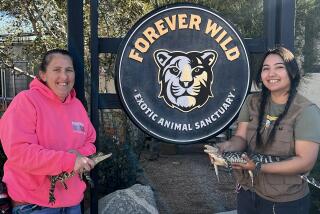Rare Gators Charm Even Those Who Want a Bite
- Share via
NEW ORLEANS — It was a unique asset in a $3.23-billion oil-and-gas merger: a dozen blue-eyed alligators with ivory scales.
“Is it real, Mommy?” a wide-eyed girl asks. Her question is echoed by another child, and another, as families move through the exhibit at the aquarium. Then: “He’s moving! He’s moving!”
Remy Lazare, their keeper, says children have asked, “Are they made of white chocolate?”
The blue eyes are one sign that these are not albinos, but leucistic--they still have some color. They are the only known leucistic alligators in the world, and may be the only leucistic crocodilians. They became Louisiana Land & Exploration Co.’s unofficial mascots after 18 hatched on LL&E; land in 1987.
Fourteen are still alive. Three are on display at the New Orleans zoo and aquarium. A couple are being treated at the zoo, and the rest are at what used to be LL&E;’s alligator farm in Golden Meadow.
LL&E; got out of the alligator business as the market for hides dropped. Burlington Resources Inc., which bought LL&E; in 1997, is interested only in petroleum. It expects to decide what to do with the beasts by the end of the year. For one thing, it is selling the gator farm.
If everyone--including the Internal Revenue Service--can agree on what the gators are worth, Burlington probably will give them to the Audubon Institute, which runs New Orleans’ Audubon Zoo and the Aquarium of the Americas.
“We’ve had a long, close, good relationship with the zoo,” says Burlington spokesman James Bartlett. “They provide care for the alligators. We loan alligators to the zoo now. Whenever they have too many alligators of any type we house them. They don’t charge us; we don’t charge them.”
But there isn’t an agreement yet. As they say in business, talks continue.
The white gators were caught almost as they hatched. They were cute little critters, easily held and cooed over by television reporters.
“They totally infatuated us, and we found out they did the same to other people,” says Leighton Steward, LL&E;’s former president.
Now 14 years old, hundreds of pounds, and anywhere from 9 to 10 1/2 feet long, they’re not beasts you’d want to mess with.
What are the alligators worth? Some years back, when LL&E; wanted a value in case it gave any more to the zoo, an expert estimated that they could be worth $500,000 to $700,000 each.
Zookeepers don’t know how long these will live. Normal American alligators can live 70 years or more in captivity, but keeper Lazare said the leucism gene seems to be connected somehow to the immune system.
“These guys seem to be a bit more fragile than other gators,” she said.
One of the aquarium’s gators died in 1998 of zinc poisoning from pennies thrown into its tank. Another at the zoo died last year of pneumonia. On the Golden Meadows farm, the only female of the clutch was attacked and killed by a white bull gator.
Audubon Institute’s veterinary care to the Golden Meadow gators has included clearing lead pellets out of their gullets and treating them for lead poisoning, since the nutria meat which makes up much of their diet often contains shotgun pellets.
“We’re concerned about the welfare of the animals. We want to make sure that they are cared for the best way possible,” says general curator Dan Malone.
The Audubon also has arranged white alligator loans to other zoos and aquariums around the country, including the San Francisco and Philadelphia zoos and the Florida Aquarium.
That has given the creatures a wider audience, and added to their value.
“We’ve helped cultivate the legend of these animals. I think that’s part of the reason they’re considered very valuable now,” Malone says. “Not just because they’re rare, but because we’ve helped get millions of people interested in these animals.”
“They are intriguing animals,” adds Rick Atkinson, curator of the zoo’s Louisiana Swamp exhibit. “Wherever they go, they command a certain amount of gate value.”
More to Read
Inside the business of entertainment
The Wide Shot brings you news, analysis and insights on everything from streaming wars to production — and what it all means for the future.
You may occasionally receive promotional content from the Los Angeles Times.










